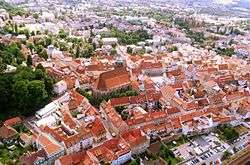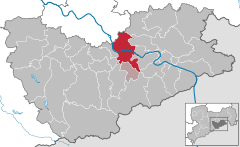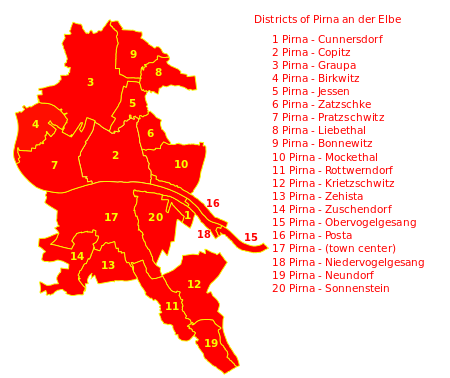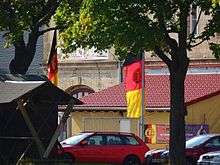Pirna
| Pirna | ||
|---|---|---|
 | ||
| ||
 Pirna | ||
Location of Pirna within Sächsische Schweiz-Osterzgebirge district 
 | ||
| Coordinates: 50°57′44″N 13°56′25″E / 50.96222°N 13.94028°ECoordinates: 50°57′44″N 13°56′25″E / 50.96222°N 13.94028°E | ||
| Country | Germany | |
| State | Saxony | |
| District | Sächsische Schweiz-Osterzgebirge | |
| Municipal assoc. | Pirna | |
| Government | ||
| • Mayor | Klaus Peter Hanke (none) | |
| Area | ||
| • Total | 53.02 km2 (20.47 sq mi) | |
| Population (2015-12-31)[1] | ||
| • Total | 38,010 | |
| • Density | 720/km2 (1,900/sq mi) | |
| Time zone | CET/CEST (UTC+1/+2) | |
| Postal codes | 01781–01796 | |
| Dialling codes | 03501 | |
| Vehicle registration | PIR | |
| Website | www.pirna.de | |
Pirna (Upper Sorbian: Pěrno) is a town in the Free State of Saxony, Germany, capital of the administrative district Sächsische Schweiz-Osterzgebirge. The town's population is over 37,000. Pirna is located near Dresden and is an important district town as well as a Große Kreisstadt. It is also known for the gassing of about 15,000 disabled people in Sonnenstein Castle between June 1940 and August 1941, killings which ceased after pressure was exerted on the authorities by the local population. Today, a small plaque at the base of Sonnenstein Castle and the Sonnenstein Memorial remembers the dead.
Geography
Geographical location
Pirna is located near the Sandstone Mountains in the Elbe valley, where the nearby rivers Wesenitz, in the north, and Gottleuba to the south, flow into the Elbe. Pirna is also called the "gate to the Saxon Switzerland" (Ger: Tor zur Sächsischen Schweiz). The Saxon wine region (Sächsische Weinstraße), stretches from Pirna over Pillnitz, Dresden, and Meissen to Diesbar-Seußlitz, was dedicated in 1992. In August 2002, the town suffered great damage in the widespread flooding in Europe at the time. This was particularly unfortunate as it undid many well-executed restoration schemes carried out post 1990 re-unification.
Neighbouring municipalities
Pirna is located southeast of Dresden. Neighbouring municipalities are Bad Gottleuba-Berggießhübel (town), Bahretal, Dohma, Dohna (town), Dürrröhrsdorf-Dittersbach, Heidenau (town), Königstein (town), Lohmen, Stadt Wehlen (town), and Struppen.
Names
- Czech: Perno
- French: Pirne
- German: Pirna
- Upper Sorbian: Pěrno
History
⎈ Samo’s Empire 631-658
Bishopric of Meissen 1233-1293
![]() Kingdom of Bohemia 1293-1405
Kingdom of Bohemia 1293-1405
![]() Electorate of Saxony 1405-1697
Electorate of Saxony 1405-1697
![]() Poland-Saxony 1697-1706
Poland-Saxony 1697-1706
![]() Electorate of Saxony 1706-1709
Electorate of Saxony 1706-1709
![]() Poland-Saxony 1709-1763
Poland-Saxony 1709-1763
![]() Electorate of Saxony 1763-1806
Electorate of Saxony 1763-1806
![]() Kingdom of Saxony 1806-1918
Kingdom of Saxony 1806-1918
![]() German Empire 1871-1918
German Empire 1871-1918
![]() Weimar Republic 1918-1933
Weimar Republic 1918-1933
![]() Nazi Germany 1933-1945
Nazi Germany 1933-1945
![]() Allied-occupied Germany 1945-1949
Allied-occupied Germany 1945-1949
![]() East Germany 1949-1990
East Germany 1949-1990
![]() Germany 1990-present
Germany 1990-present
Stone Age
Tools made of flint from the late Paleolithic (about 12,000-8000 BC), at the end of the last ice age, are evidence for the earliest human settlement in the area. Later on, people belonging to the Linear Pottery culture, who farmed grain and cattle, lived here during the Neolithic (5500-4000 BC) because of a good climate and Loess. Around 600 AD a Slavic group called the Sorbs, who were fishermen and farmers, succeeded the Germanic tribes in the Elbe Valley, who had lived in the area for a couple of centuries from the 4th century BC on. The name Pirna derives from the Sorbian phrase, na pernem, meaning on the hard (stone) and is also related to the Slavic deity Perun, whose cult was present i all Slavic and Baltic territories. The representation of a pear tree in the coat of arms was a later cryptic representation of the Perun cult, covered up by a fanciful, German-language notion about the town's name ("pear" is Birne in German, which sounds rather like "Pirna" Latin: "Pyrus").
Middle Ages
With the conquest of the Slavic communities and the founding of the Mark by the Germans (Henry the Fowler founded the castle of Meissen in 929), settlement in the Pirna area is again verifiable. The castle in Pirna, which was mentioned for the first time in 1269, probably already existed in the 11th century. In the context of the second Eastern German colonization the town was founded by Henry III, Margrave of Meissen.
The streets are aligned from east to west and from north to south forming a chessboard-like system. Only the streets east of the church are not in this shape because of the nearby Burgberg. In 1233, Pirna was mentioned for the first time in a document. In 1293, King Václav II. of Bohemia bought the town and the castle from the Bishop of Meissen. Thus Pirna belonged to Bohemia until 1405.
Early Modern times
In 1502, the construction of the new church was begun under Meister Peter Ulrich von Pirna.
With the introduction of the Reformation into Saxony in 1539, Anton Lauterbach, a friend of Martin Luther's, became pastor and superintendent. In 1544 the strategically important castle was upgraded to a fortress by Maurice, Elector of Saxony. Three years later it withstood the siege by elector John Frederick, Elector of Saxony in the Schmalkaldic War.
On April 23, 1639, the town was invaded by Swedish troops under the commander in chief of the Swedish army, Johan Banér. During the futile five-month siege of the fortress the town was greatly devastated. About 600 people were murdered (Pirnarisches Elend, lit. "Misery of Pirna"). In around 1670, the Sonnenstein fortress was built with modern military insights. Only the powerful stonework still exists today. In 1707, Pirna had debts that related to the Great Northern War of more than 100,000 Thalers.
Prussian Pirna
On August 29, 1756, the small Saxon army fled before the Prussians, who had invaded without declaring war, to the levels between Königstein Fortress and Sonnenstein Castle and capitulated there on October 16, two days after Sonnenstein surrendered. In 1758, Austrian troops and the Imperial Army besieged the fortress.
Napoleonic Pirna
Manufacturing plants opened in 1774 in Pirna. In 1811 the physician Ernst Gottlob Pienitz opened a very large mental hospital in Castle Sonnenstein. But on September 14, 1813, French troops occupied Sonnenstein, forcing the evacuation of 275 patients, seizing supplies and tearing the roof trusses out to remove the threat of fire. In September 1813, emperor Napoleon temporarily lived at the Marienhaus at the market. Until Dresden's surrender on November 11 the French defended the fortress. Only in February did the hospital for the mentally ill open again.
Industrial revolution, Imperial Germany and the Weimar Republic
In 1837, steamship travel began on the upper Elbe. A few years later, a railway line connecting Dresden and Pirna opened. Pirna became an industrial town in 1862 with the building of factories. Mechanical engineering, glass, cellulose and rayon production also expanded. In 1875, the sandstone Elbbrücke (bridge on the Elbe) was completed. During the First World War Pirna became a garrison and the engineer battalions 12 and 5 of the Royal Saxon field artillery regiment No. 64 were billeted on Rottwerndorfer Straße. In 1922/23, the town absorbed several municipalities including Posta, Niedervogelgesang, Obervogelgesang, Copitz, Hinterjessen, Neundorf, Zuschendorf, Rottwerndorf and Zehista. The population then totalled 30,000 inhabitants.
Holocaust
World War II - From early 1940 until end of June 1942, a part of the huge mental asylum within Sonnenstein Castle overlooking Pirna was converted into a euthanasia killing centre: the Sonnenstein Nazi Death Institute. This was the first use of techniques later rolled out and refined for use within the Final Solution. A gas chamber and crematorium were installed in the cellar of the former men's sanitary (building C 16). A high brick-wall on two sides of the complex shielded it from outside while a high hoarding was erected on the other sides. Four buildings were located inside the shielding. They were used for offices, living rooms for the personnel etc. Sleeping quarters for the "burners" (men who burned the bodies) were provided for in the attic of building C 16. It is possible that other sections of the buildings were also used by T4.
From end of June 1940 until September 1942, approximately 15,000 persons were killed in the scope of the euthanasia programme and the Sonderbehandlung 14f13. The staff consisted of about 100 persons. One third of them were ordered to the extermination camps in occupied Poland, because of their experiences in deception, killing, gassing and burning innocent people.
There they were trained by the killing groups who mounted the killing machinery in the later camps like Treblinka from TishBeAv 1942 and the others.
During August and September 1942, the Sonnenstein killing centre was closed and incriminating installations such as gas chamber installations and crematorium ovens dismantled. After October 1942, the buildings were used as a military hospital.
This part of the history of Pirna went largely unrecognized in Germany until 1989, but after that efforts to remember that catastrophe started. In June 2000 the permanent exhibition opened .[2]
Floods of 2002
Pirna has a long history of flooding due to its position on the River Elbe.
Pirna was particularly badly hit by the flooding of the Elbe in 2002, reaching its apex on 16 August.
Two factors greatly worsened the effect. Firstly, the large earth structure supporting the railway line acted as a dam, retaining the waters for longer and deeper on the town side. Secondly the many shop-fronts which had been renewed post-unification were all sealed in terms of water-tightness: the floodwaters rose outside whilst the units inside stayed dry, but at certain critical points the weight of the water suddenly destroyed the shopfronts. Ironically the older "leaky" shopfronts did not suffer this fate as the water built up equally on each side. Whilst international media mainly concentrated on the impact upon Dresden the impact upon Pirna was proportionately much worse. Schöna and Bad Schandau were also hit.
In June 2013 a further severe flood occurred but failed to meet the record levels of the 2002 flood.
Amalgamations

The cities that were amalgamated with Pirna are:
- 1850: Hausberggemeinde
- 1922/23: Posta, Niedervogelgesang, Zuschendorf, Neundorf, Rottwerndorf, Hinter-Jessen und Copitz
- 1930: Zehista
- 1950: Cunnersdorf, Mockethal, Zatzschkepp
- 1971: Liebethal
- 1974: Krietzschwitz, Obervogelgesang
- 1998: Birkwitz-Pratzschwitz, Graupa
Population
Change of Population (from 1960, all figures for December 31):
|
1834 until 1946
|
1950 until 1997
|
1998 until 2003
|
1 October 29
2 August 31
Culture and sites of interest

Museums
- Pirna museum = Stadtmuseum Pirna, located at 2 Klosterhof
- Botanical collections and Landschloss Pirna - Zuschendorf
- DDR Museum - museum devoted to East Germany memorabilia
- Richard Wagner Museum Graupa
Music
- Neue Elbland Philharmonie with 60 musicians and about 160 concerts every year.
- Pirnaer Jazznacht, which in 2004 took place for the fifth time.
Dialect
The dialect spoken in Pirna is Südostmeißenisch, which is part of the Upper Saxon German group of dialects.
Twinned towns
 - Varkaus, Finland - since 1961
- Varkaus, Finland - since 1961 - Děčín, the Czech Republic - since 1975
- Děčín, the Czech Republic - since 1975 - Longuyon, France - since 1980
- Longuyon, France - since 1980 - Bolesławiec, Poland - since 1980
- Bolesławiec, Poland - since 1980 - Remscheid (North Rhine-Westphalia) - since 1990.
- Remscheid (North Rhine-Westphalia) - since 1990.
Pirna is bound with Baienfurt and Reutlingen, both in Baden-Württemberg, in town friendships.
Persons
- Johann Tetzel (1465–1519), German Dominican friar, Grand Inquisitor of Heresy to Poland
- Ioannes Sommerus (1542–1574), Transylvanian theologian and chronicler
- Theophilus Jacobäer (1591–1659), German pharmacist, "rescuer" in the Thirty Years' War (de)
- Johann Siegmund von Liebenau (1607–1671), captain and Commander-in-Chief of fortresses in Saxony (de)
- Dr. Ernst Gottlob Pienitz (1777–1853), German psychiatric reformer (de)
- Carl Wilhelm Häcker, aka Carl William Häcker (1819–1886), pioneer of photography[3]
- William Adolph Haußner (1819–1849), physician and town delegate, revolutionist from 1848-49[4]
- Friedrich August Greif (1830–1905), founder of the Greif endowment[4]
- Anna Marie Geibelt (1838–1923) (de)
- Gertrud Eysoldt (1870–1955), German actress and director (de)
- Hugo Küttner (1880–1945), German entrepreneur (de)
- Siegfried Rädel (1893–1943) - communist town delegate
- Eva Schulze-Knabe (1907–1976), German painter
- Oskar Speck (1855–1922), founder of the town scientific historiography in Pirna (de)
- Hermann Rosa (1911, Pirna - 1981, Munich), German sculptor and architect
See also
References
- ↑ "Aktuelle Einwohnerzahlen nach Gemeinden 2015] (Einwohnerzahlen auf Grundlage des Zensus 2011)" (PDF). Statistisches Landesamt des Freistaates Sachsen (in German). July 2016.
- ↑ "Pirna-Sonnenstein Memorial".
- ↑ http://www.handel-sachsen.de/index.php?shlink=1150, http://www.geschichte-pirna.de/neuere_publikationen.htm, http://www.pirna.de/Fotothek.4169/
- 1 2
External links
| Wikimedia Commons has media related to Pirna. |
- General map Street map of Pirna
- Pirna's archives
- The historical old town of Pirna - a virtual town guide
- Kuratorium Altstadt e.V.
- Erlpeter, with articles of history
- Contributions to Pirna's history (by Hugo Jensch)
- Sonnenstein Memorial
- Pirna portal
- Pirna portal
- Programme of its festivities


